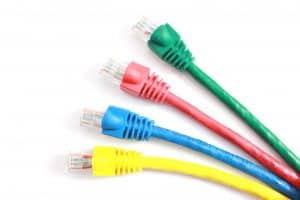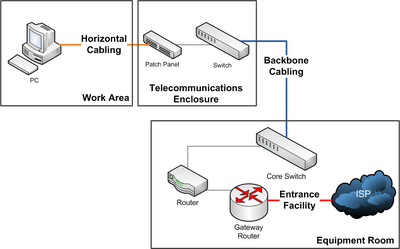
A network cabling system is a set of cables, connectors, and other devices that are used to connect computers and other electronic equipment together in order to form a network12. The cables can be made of either copper or glass, and they carry information from one network device to another2. A network cabling system can include patch panels, switches, and other devices that help to manage the network traffic and performance1.
Cabling is the set of wires made of either copper or glass that is used to connect computers and other network components to enable them to communicate, thus forming a network of computers.
What is Network Cabling?
In other words, Network Cabling is the medium through which information usually moves from one network device to another. There are several types of cable which are commonly used with LANs. In some cases, a network will utilize only one type of cable, other networks will use a variety of cable types. The type of cable chosen for a network is related to the network’s topology, protocol, and size. Understanding the characteristics of different types of cable and how they relate to other aspects of a network is necessary for the development of a successful network.
Laying cables is the foundation for both creating local area networks (LANs) and connecting LANs into wide area networks (WANs). Network administrators are usually involved only in the planning and laying of LAN cabling since WAN cabling is the responsibility of telecommunications carriers.

How Cabling Works
There are two basic types of cabling used in LAN networking environments:
- Copper cabling, which consists of insulated copper conductors that transmit signals using electrical voltages and currents. Copper cabling can be either coaxial cabling (such as thinnet or thicknet) that is used mainly in industrial environments, or the more commonly employed twisted-pair cabling. Twisted-pair cabling comes as either unshielded twisted-pair (UTP) cabling (commonly used in Ethernet or Fast Ethernet environments) or the less common shielded twisted-pair (STP) cabling (employed for token ring networks and sometimes for Gigabit Ethernet installations). Copper cabling is mainly used for shorter cable runs such as horizontal cable runs between wiring closets and wall plates in work areas, for patch cables, and for equipment interconnects.
- Fiber-optic cabling, which is made of glass strands that transmit signals as light waves or pulses. Fiber-optic cabling can be either single-mode, which is used for the longest cable runs, or multimode, which has a much higher carrying capacity. Fiber-optic cabling is generally used for backbone cable runs such as vertical rises in buildings and building-to-building interconnects on a campus, for high-speed interconnects between networking devices in a wiring closet, and for connections to high-speed servers and workstations.
The Telecommunications Industry Association (TIA) and Electronic Industries Alliance (EIA) have defined a series of standards on proper layout and organization of premise cabling called the EIA/TIA wiring standards. Cabling installed in a building must meet all legal requirements, including federal and local building regulations. Do not attempt to wire a building unless you are fully familiar with the required regulations. The EIA/TIA-568A Commercial Building Telecommunication Cabling Standard specifies standards for each of the following:
- Establishing wiring closets on each floor of the building to contain rack-mounted equipment such as hubs, switches, and patch panels;
- Running vertical backbone plenum cabling through building risers and building plenums, for connecting wiring closets to the main equipment room;
- Running horizontal PVC (polyvinyl chloride) cabling for each floor through false ceilings;
- Connecting the patch panels in the wiring closet to wall plates in computer work areas.
Specialized cables – such as serial, parallel, or SCSI cables – are used to connect peripherals, and therefore do not serve the same purpose as the cables just discussed. Serial cables and other special-purpose cables are generally very short and are not permanently installed. Cabling for a LAN must be installed according to the standards described in the previous list. Not all networks use physical cabling. Wireless networks can use infrared, microwave, radio, or some other form of electromagnetic radiation to allow networking components to communicate with each other.
Categories of Unshielded Twisted Pair
The quality of UTP may vary from telephone-grade wire to extremely high-speed cable. The cable has four pairs of wires inside the jacket. Each pair is twisted with a different number of twists per inch to help eliminate interference from adjacent pairs and other electrical devices. The tighter the twisting, the higher the supported transmission rate and the greater the cost per foot. The EIA/TIA (Electronic Industry Association/Telecommunication Industry Association) has established standards of UTP and rated six categories of wire (additional categories are emerging).
| Category | Speed | Use |
| 1 | 1 Mbps | Telephone and modem lines |
| 2 | 4 Mbps | LocalTalk & Telephone |
| 3 | 16 Mbps | 10BaseT Ethernet |
| 4 | 20 Mbps | Token Ring |
| 5 | 100 Mbps (2 pair) | 100BaseT Ethernet |
| 5e | 100 Mbps (4 pair) | 100BaseT Ethernet |
| 6 | 1,000 Mbps | Gigabit Ethernet |
| 7 | 10,000 Mbps | Gigabit Ethernet |
| 8 | 10,000 Mbps | Gigabit Ethernet |
Choosing the right kind of cabling
Choosing the right kind of cabling at the beginning of installation can save considerable expense when networking equipment is later upgraded for higher transmission speeds.
To learn more about Cabling you have to check this book by Sybex, Cabling: The Complete Guide to Copper and Fiber-Optic Networking.
SEE ALSO:
Structured cabling
In telecommunications, structured cabling is building or campus cabling infrastructure that consists of a number of standardized smaller elements (hence structured) called subsystems. Structured cabling components include twisted pair and optical cabling, patch panels and patch cables.
Overview

Structured cabling is the design and installation of a cabling system that will support multiple hardware uses and be suitable for today’s needs and those of the future. With a correctly installed system, current and future requirements can be met, and hardware that is added in the future will be supported [1]
Structured cabling design and installation is governed by a set of standards that specify wiring data centers, offices, and apartment buildings for data or voice communications using various kinds of cable, most commonly Category 5e (Cat 5e), Category 6 (Cat 6), and fiber-optic cabling and modular connectors. These standards define how to lay the cabling in various topologies in order to meet the needs of the customer, typically using a central patch panel (which is often mounted in a 19-inch rack), from where each modular connection can be used as needed. Each outlet is then patched into a network switch (normally also rack-mounted) for network use or into an IP or PBX (private branch exchange) telephone system patch panel.
Lines patched as data ports into a network switch require simple straight-through patch cables at each end to connect a computer. Voice patches to PBXs in most countries require an adapter at the remote end to translate the configuration on 8P8C modular connectors into the local standard telephone wall socket. In North America no adapter is needed for certain uses: With ports wired in the preferred standard T568A pattern, for the 6P2C plugs most commonly used for single-line phone equipment (e.g. with RJ11), and 6P4C plugs used for two-line phones without power (e.g. with RJ14) and single-line phones with power (again RJ11), telephone connections are physically and electrically compatible with the larger 8P8C socket, but with ports wired as T568B, which is common but often in violation of the standard, only the first pair, i.e. line 1, works.[a] RJ25 and RJ61 connections are physically but not electrically compatible, and cannot be used. In the United Kingdom, an adapter must be present at the remote end as the 6-pin BT socket is physically incompatible with 8P8C.
It is common to color-code patch panel cables to identify the type of connection, though structured cabling standards do not require it except in the demarcation wall field.[specify]
Cabling standards require that all eight conductors in Cat 5e/6/6A cable be connected.
IP phone systems can run the telephone and the computer on the same wires, eliminating the need for separate phone wiring.
Regardless of copper cable type (Cat 5e/6/6A), the maximum distance is 90 m for the permanent link installation, plus an allowance for a combined 10 m of patch cords at the ends.
Cat 5e and Cat 6 can both effectively run power over Ethernet (PoE) applications up to 90 m. However, due to greater power dissipation in Cat 5e cable, performance and power efficiency are higher when Cat 6A cabling is used to power and connect to PoE devices.[1]
Subsystems
Structured cabling consists of six subsystems:[2]
- Entrance facilities is the point where the telephone company network ends and connects with the on-premises wiring belonging to the customer.
- Equipment rooms house equipment and wiring consolidation points that serve the users inside the building or campus.
- Backbone cabling is the inter-building and intra-building cable connections in structured cabling between entrance facilities, equipment rooms and telecommunications closets. Backbone cabling consists of the transmission media, main and intermediate cross-connects and terminations at these locations. This system is mostly used in data centers.
- Horizontal cabling wiring can be standard inside wiring (IW) or plenum cabling and connects telecommunications rooms to individual outlets or work areas on the floor, usually through the wireways, conduits or ceiling spaces of each floor. A horizontal cross-connect is where the horizontal cabling connects to a patch panel or punch up block, which is connected by backbone cabling to the main distribution facility.
- Telecommunications rooms or telecommunications enclosure connects between the backbone cabling and horizontal cabling.
- Work-area components connect end-user equipment to outlets of the horizontal cabling system.
Standards
Network cabling standards are used internationally and are published by ISO/IEC, CENELEC and the Telecommunications Industry Association (TIA). Most European countries use CENELEC, International Electrotechnical Commission (IEC) or International Organization for Standardization (ISO) standards. The main CENELEC document is EN50173, which introduces contextual links to the full suite of CENELEC documents. ISO/IEC 11801 heads the ISO/IEC documentation.[3] In the US, the Telecommunications Industry Association issue the ANSI/TIA-568 standards for telecommunications cabling in commercial premises.
Certainly! In a structured cabling environment, you’ll typically find the following types of cables1234:
- Ethernet Cables: These are commonly used for local area networks (LANs) and internet connections. They include twisted pair cables (such as Cat5e, Cat6, and Cat7) and provide reliable data transmission.
- Fiber Optic Cables: Known for their high-speed data transmission capabilities, fiber optic cables use light signals instead of electrical signals. They’re ideal for both indoor and outdoor environments due to their immunity to interference.
- Coaxial Cables: Coaxial cables (or “co-ax”) consist of an insulating layer surrounding an inner conductor, shielded by a conductive layer. They’re often used for cable TV, internet, and telephone connections.
- Twisted Pair Cables: Twisted pair cables come in various categories (Cat3, Cat5, Cat6, etc.). They’re cost-effective and suitable for both indoor and certain outdoor applications. Twisting the pairs reduces interference.
- AC Power Cables: While not strictly part of structured cabling, AC power cables provide electrical power to devices within the network infrastructure.
- Special Data Transmission Cables: These may include specialized cables for specific purposes, such as serial communication or industrial applications.
Remember that the choice of cabling depends on your business’s needs, budget, and the environment in which it will be deployed. 😊🔌
Active cables are copper cables used for data transmission that use an electronic circuit to boost the performance of the cable1234. They are used for longer distances and maintaining signal integrity2. Passive cables are prone to data degradation from channel impairments, including attenuation, crosstalk, and group velocity distortion1. They are simpler and more affordable than active cables2. Passive cables do not draw power from the switches, while active ones do5. DisplayPort to VGA adapters are always active, while DisplayPort to HDMI/DVI adapters can be active or passive3.
